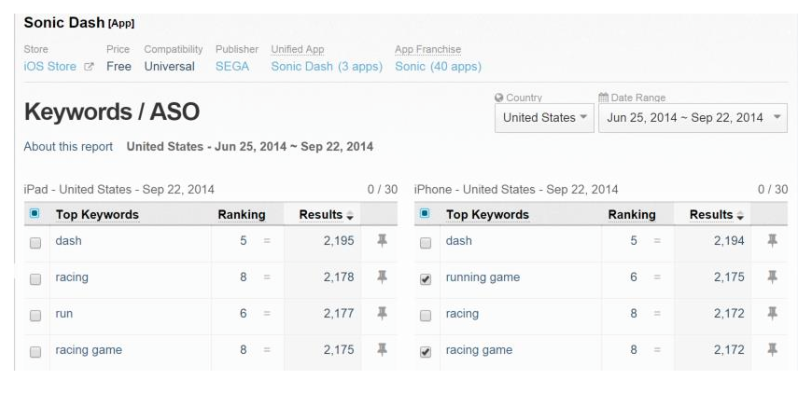Head of the Venturebeat Insight online resource Development Department Michia Rohrssen advises exactly how to promote the app so that it gets into the top App Store.
Creating a successful application is a difficult task. Sometimes everything seems to be done correctly – and yet, users pass by the project. And other applications, such as Flappy Birds, seem to be assembled “on the knee”, and still become popular.
Of course, the success of the project is determined by thousands of reasons. However, all successful applications have one thing in common.
High ratings in the App Store
This is a single factor for all genres and all types of applications.
The rating in the App Store does not exist to amuse the self-esteem of the authors. Research claims: 63% of downloads are due to searches of the top App Store.
In other words, if your application is in the top, it is guaranteed success.
The bad news is that more than 1,000 games and apps are released every day. And the good one? Getting into the top is not as difficult as you think.
Here are tips that will help you with this.
Keywords
Finding the right keywords is the first step on the way to the top. So let’s make sure you’re doing everything right.
Look at the competitors. Why reinvent the wheel?
The easiest way to find the right keywords is by studying the applications of your main competitors. Since they are in the top, it means they have found the right algorithm. Why not borrow valuable information for your own benefit?
Start with the keywords that your competitors use. There are many ways to get results. The author of this article prefers App Annie, because the resource has simple management and basic functions are free.
 Another way to borrow the experience of competitors is to view reviews of their applications. Analyze which keywords your target audience uses. Such tactics can yield unexpectedly valuable fruits.
Another way to borrow the experience of competitors is to view reviews of their applications. Analyze which keywords your target audience uses. Such tactics can yield unexpectedly valuable fruits.
Add some new ideas
 You’ve got a list of keywords that your top competitors use. Now it would be nice to add something from yourself. Come up with a few short sentences that describe your app and add them to the list.
You’ve got a list of keywords that your top competitors use. Now it would be nice to add something from yourself. Come up with a few short sentences that describe your app and add them to the list.
You can add keywords by simply typing the main word into the App Store or Google search bar and choosing what will give you an automatic offer.
Choose the best options
Now that you have a list of potential keywords and their combinations, it’s time to choose the ones you really need.
The easiest way is to find out how many similar apps use the same keywords. Above is the graph that App Annie got, however, any other resource can be used for this purpose.
From the resulting list, you need to select one main keyword and 5-10 minor ones.
The main word is the one that best reflects the essence of your application. You will use it when you optimize your project.
For secondary keywords, it is better to choose 3 rarely occurring, 3 words occurring with moderate frequency and 3 frequently occurring. Change this ratio depending on how confident you are in the competitiveness of your application.
Keywords found? Let’s move on to the most interesting part. We will optimize the application so that it gets into the tops.
It’s all about the name
There is one very simple way to improve your rating. Optimize the name. Research shows that in the App Store, the rating of titles with keywords in the title is on average 10.3% higher.
So carefully evaluate the name of your application. Does it have the main keyword? Can I add this word to it?
In the headers of some applications, you simply will not be able to add what you need. In such cases, you can hyphenate the keyword. For example, “CamScanner – Phone PDF Creator”.
Remember that short names tend to give better results than long ones, so don’t get carried away.
Optimize the description
The next thing a potential user will see after the title is a description. A good description not only attracts users, it also raises the rating of the application (we talk in detail about how to create the right description here, – approx. editorial offices).
One-third rule
This refers to the first three lines of your application. They are the ones that are crucial. Attract the user’s interest – and he will read the rest and maybe even download the application. Will it be boring? So, it will go to competitors.
Think about which three lines will make your target audience read on. If you have awards worth mentioning, tell us about them. Sometimes the best tactic is just to tell what your application can do and what advantages it has.
Completing the description
After you have the first three lines ready, you can start inserting keywords. Make sure they are appropriate. Attempts to cram keywords into every line equally irritate the moderators of the stores and your potential users.
Be creative
Too many applications put keyword 1, keyword 2 and so on in the description head-on. It’s not only boring – it immediately seems that the description was made “carelessly”.
Use your imagination and figure out how to put keywords in the description so that it doesn’t repel. Here’s how, for example, Farm Tower did it: “You will like cute little animals (pig, cow, chicken, sheep, bull, cat – and no angry birds;))”.
They managed to put a lot of keywords in the description – and even the keyword of the main competitor – but in such a way that it doesn’t look like spam.
Optimize the keyword section
Now that you have the main and secondary keywords, adding them to your application is easy. However, there are a couple of tricks that can be used to squeeze the best out of them.
Use numbers, not words
The keyword section of your application has strict limits on the number of characters, so wherever possible, use numbers, not words.
Not plural, but singular
It seems that the difference is small, but it will also help to save precious signs.
Don’t use the name of your app as a keyword
It makes no sense to repeat the name in keywords – unless it itself consists of keywords.
Use all characters
The rating of your application depends, among other things, on the section with keywords, so do not let precious symbols remain unused. Each of them counts, and there is no reason why they should be neglected.
The more ratings – the higher the rating
The average rating of your application, as well as the number of reviews, is the main factor that leads to the top.
The easiest way to get feedback is simply by asking users about it.
If you have already asked users the sacramental question “Do you like our app?”, you need to experiment with exactly how and when you do it.
First try changing the message. Use a different design, a different title, a different message text and even different labels on the buttons.
Once this issue is settled, try changing the time when the message appears. Maybe the best reviews will be after 3 hours of play, maybe after passing a certain level. Or the best results will be after the user has launched your application for 7 days in a row.
There are many options, so just take it and look for the best one.
Increase the number of downloads
It’s no secret that the more downloads, the higher the rating. The tactics already mentioned will bring excellent results – but you won’t get to the top without a significant number of downloads. In addition to optimizing keywords and descriptions, make sure that you are constantly stimulating new downloads using various methods – from advertising on social networks to paid downloads.
Increase the speed of downloads and feedback
Reviews and downloads are key factors, just like the speed with which you receive them. Both Google and Apple track the speed at which your apps collect them and select the most popular new projects. These new projects have all kinds of advantages, but most importantly, they are featured on the main page of the stores.
Join a short-term campaign
Such campaigns are short, time-limited and attract a stream of new users and reviews. An example of such a company is Apple’s Red.
If you do everything right, the campaign will create a snowball effect, and turn your app into a hit.
Other materials on the topic:

